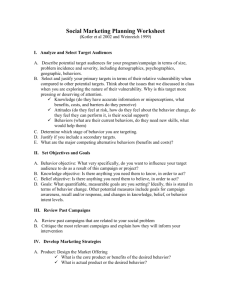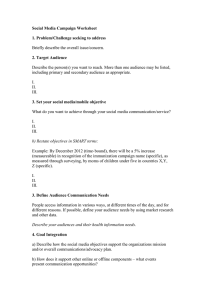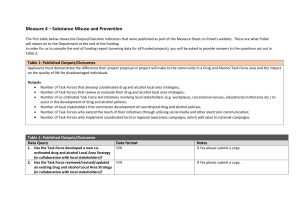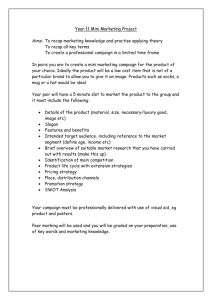How to use modern media in campaigns against
advertisement
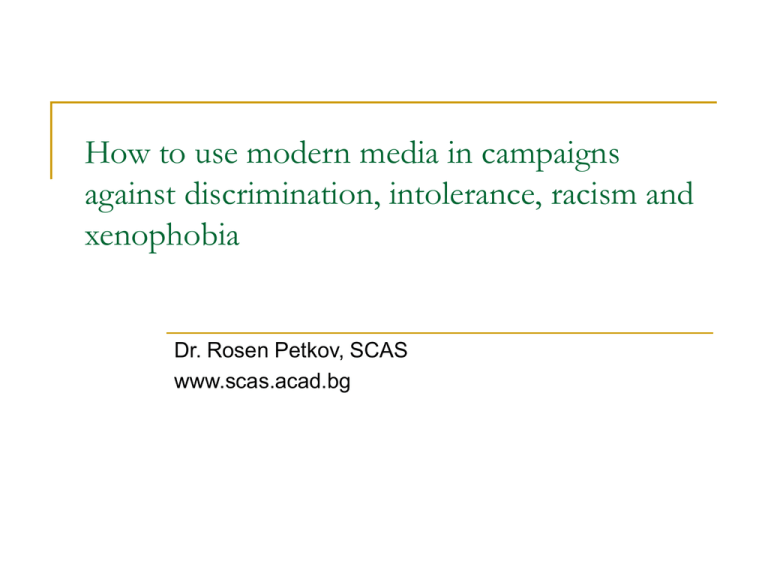
How to use modern media in campaigns against discrimination, intolerance, racism and xenophobia Dr. Rosen Petkov, SCAS www.scas.acad.bg What is a Campaign? Some of the more useful definitions are as follows: Campaigning is speaking up, drawing a community’s attention to an important issue, and directing decision-makers towards a solution. Campaigning involves putting a problem on the agenda, providing a solution to that problem and building support for action to solve the problem. Campaigns can involve many specific, short-term activities to reach a long-term vision of change. A campaign is a series of actions directed at changing the policies, positions or programmes of any type of institution. Campaigning involves working with other people and organisations to make a difference. Campaigning consists of differing strategies aimed at change at the local, provincial, national and/or international levels. Types of Campaigns Mobilising and involving people – for example, anti-crime campaigns or the polio campaign Presurising decision makers – for example, marches to councils / police stations demanding national or global action. Informing and educating the public – for example, voter education campaigns Changing behaviour and attitudes – for example, HIV/AIDS campaigns such as the TAC campaign detailed at the end of this section. And finally, campaigns that build a positive image for an organisation or a brand – for example, the campaign to market South Africa as a tourism destination. Campaign Tools Using the Media Building networks and coalitions Advocacy and lobbying government Direct Action Action Research Using Formal Political Processes Using the Law Using the media Once you have done your research and analysis, you have to develop a clear communications strategy. Communication is at the centre of any campaign strategy. A successful organisation and campaign needs to build a profile to which people can relate. A good communications strategy will ensure that the right information reaches your target audiences (supporters, decision-makers, opponents, public) both inside and outside the campaign. Media is the most common tool supporting any communication strategy. How to develop a campaign and communication strategy Your communication strategy should include the following elements: Identify the key message themes that you want to communicate to your target audience. Develop a communications strategy to get your message across to the audience. Develop a slogan and a media design identity like a logo. Draw up a media plan with budgets and time-frames. Develop a public relations plan. Develop a campaign and training strategy that focuses on : Reaching and mobilising your target audience Training and developing capacity among the key players in your organisation who have to implement the campaign. Critical success factors Understanding media bias to create stories and hold events that are tailored to specific media interests. Follow up all stories and interviews. All media is under-funded and almost no media outlet has the time and resources to investigate all the news it needs or wants to cover. Build personal relationships with as many media outlets as possible. Trust and relationships are crucial to working with the media. Give them reliable and good informationл Provide clear simple information to minimize the risk of your message being diluted. Most media forms require simple, clear messages. Tell stories. Be sure to translate your information into something that is understandable to the general public. Example 1 A human story about tuberculosis Fact: 11 million children under five die each year of preventable illnesses. Translate it to story ? Example 1 Story: Virgilio lives in East Timor. He is two and has tuberculosis. Tuberculosis is one of the major public health problems faced by people in East Timor. Around 500 people in every 100 000 are infected, with 4 000 new cases per year. In England, Wales and Ireland there are only 12 cases per 100 000. (Source: ……… information fact file) Example 1 Provide a story that has drama. As far as possible, try to plan media events to occur when there is no other major event likely to dominate the news. Always be responsive to the media. There is no such thing as ‘no comment’. Follow up on media coverage. If reporting is inaccurate, respectfully call the reporter and correct the information. Be creative. The media likes something interesting. Media actions Press releases Media alerts Media events or conferences Go-and-see trips Photography Websites Email messaging Cell phone messaging Community meetings Goodwill ambassadors Advantages and disadvantages of different media- example Display media – posters, calendars, wall charts, etc Advantages popular, visualz longevity, public relations potential Disadvantages limited space for information audience must be able to read and understand the language Advantages and disadvantages of different media- example Mass electronic media – radio, television Advantages Disadvantages direct reach large audiences accessible Disadvantages require production skills time-bound can send mixed message Modern media usage examples SMS technology in the Philippines In January 2001, thousands of Filipinos, unhappy with their corrupt government, took to the streets to demonstrate against President Joseph Estrada, ultimately forcing him to resign. Mobile phones played a key role in stimulating and organising the protests – using not voice communications, but short text messages (SMSs) sent from one phone to another, or from one phone to many others. First they were used to send political jokes; later they spread the word on where demonstrations were being held. Modern media usage examples Using email lists to work together Email is the simplest and most readily available form of online communication. A mailing list is an automatic message-sending programme that stores a list of email addresses for all the people who need to be linked into the campaign. In order for the list to work effectively, the people on it must all have a common purpose and be committed to using email regularly, and it must have a facilitator who is responsible for updating everyone. Some concrete modern media tools for campaigns Bulk Email Software Mass Mailer Blogs, discussion forums SMS Easy to communicate tools – directories with phones, e-mail addresses of specific target groups E-voting tools E-games Building digital communities Some sensitive issues related to using modern media against discrimination, xenophobia, tolerance access of disadvantaged people Language barriers skills to use the media confidence to use new media abilities to access (of disabled people)
